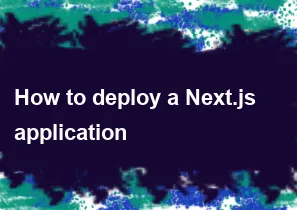How to deploy a Next.js application

Deploying a Next.js application involves several steps, and there are multiple hosting platforms you can choose from. Below, I'll provide a general guide for deploying a Next.js application. Keep in mind that the specifics may vary depending on your hosting platform.
Prerequisites:
Next.js App Setup: Make sure your Next.js application is complete and runs successfully locally.
Version Control: It's a good practice to use version control (e.g., Git) for your project.
Deployment Steps:
Choose a Hosting Platform: Decide where you want to deploy your Next.js app. Popular choices include Vercel, Netlify, AWS, Heroku, and others.
Prepare Your App for Deployment:
- Ensure your
package.jsonfile has all the necessary dependencies listed. - Double-check that your
.gitignorefile is appropriately configured to exclude unnecessary files.
- Ensure your
Configure Environment Variables: If your application uses environment variables, make sure to configure them on your hosting platform.
Build Your Next.js App: Run the following command to generate a production-ready build of your Next.js app:
bashnpm run buildChoose a Start Command: Update your
package.jsonfile to include a start command that Next.js will use in production. Add or update the"scripts"section:json"scripts": { "start": "next start" }Test Locally: Before deploying, test your app locally using the production build:
bashnpm startGit Commit: Commit your changes to Git. This is crucial for some hosting platforms that deploy from a Git repository.
bashgit add . git commit -m "Prepare for deployment"Choose a Hosting Platform (Specific Steps):
Vercel:
- Connect your Git repository to Vercel.
- Vercel will automatically detect your Next.js app and deploy it.
Netlify:
- Connect your Git repository to Netlify.
- Set the build command to
npm run buildand the publish directory toout(orpublicif that's your output directory).
AWS (Amazon S3 and AWS Lambda):
- Use AWS services like S3 for static assets and Lambda for serverless functions.
- Configure AWS services based on your project's needs.
Heroku:
- Set up a Heroku app and connect it to your Git repository.
- Configure the necessary buildpacks for Node.js applications.
Monitor Your Deployment: Most hosting platforms provide logs and monitoring tools. Check these to ensure your deployment is successful.
Custom Domain (Optional): If you have a custom domain, configure it based on your hosting platform's instructions.
SSL Certificate (Optional): If your hosting platform provides SSL certificates, enable them for secure connections.
Scaling (Optional): Configure scaling options based on your expected traffic.
Testing: Test your live deployment thoroughly to ensure everything is working as expected.
Additional Tips:
Continuous Deployment: Set up continuous deployment so that your app is automatically deployed whenever changes are pushed to the repository.
Documentation: Check the documentation of your chosen hosting platform for any platform-specific configurations.
Remember to refer to the specific documentation of the hosting platform you choose, as deployment steps can vary.
-
Popular Post
- How to optimize for Google's About This Result feature for local businesses
- How to implement multi-language support in an Express.js application
- How to handle and optimize for changes in mobile search behavior
- How to handle CORS in a Node.js application
- How to use Vue.js with a UI framework (e.g., Vuetify, Element UI)
- How to configure Laravel Telescope for monitoring and profiling API requests
- How to create a command-line tool using the Commander.js library in Node.js
- How to implement code splitting in a React.js application
- How to use the AWS SDK for Node.js to interact with various AWS services
- How to use the Node.js Stream API for efficient data processing
- How to implement a cookie parser middleware in Node.js
- How to implement WebSockets for real-time communication in React
-
Latest Post
- How to implement a dynamic form with dynamic field styling based on user input in Next.js
- How to create a custom hook for handling user interactions with the browser's device motion in Next.js
- How to create a custom hook for handling user interactions with the browser's battery status in Next.js
- How to implement a dynamic form with dynamic field visibility based on user input in Next.js
- How to implement a dynamic form with real-time collaboration features in Next.js
- How to create a custom hook for handling user interactions with the browser's media devices in Next.js
- How to use the useSWRInfinite hook for paginating data with a custom loading indicator in Next.js
- How to create a custom hook for handling user interactions with the browser's network status in Next.js
- How to create a custom hook for handling user interactions with the browser's location in Next.js
- How to implement a dynamic form with multi-language support in Next.js
- How to create a custom hook for handling user interactions with the browser's ambient light sensor in Next.js
- How to use the useHover hook for creating interactive image zoom effects in Next.js